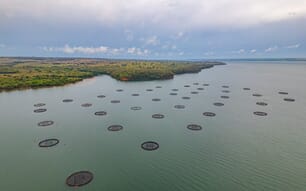According to FAO’s latest Globefish report, published today, the main season for farmed shrimp in Asia ended in November with an overall sluggish trend in production. This went against the earlier forecast of increased production in 2016.
Preliminary production reports suggest that recovery in Thailand and strong harvests in Ecuador were not enough to offset the falling production of farmed shrimp in China and Vietnam due to persistent shrimp disease and related issues. The average per hectare harvest in Vietnam reportedly declined by 50 percent, due to poor quality shrimp fry and slow growth. Due to production issues, both China and Vietnam had to import large quantities of shrimp for reprocessing and export.
Overall production in India and Indonesia, the two other large producers of farmed shrimp in Asia, is expected to be lower than the early 2016 forecast. In Latin America, farmed shrimp production increased moderately in Ecuador, but in Mexico disease and premature harvests negatively impacted volume growth. Farmed shrimp supplies also did not improve in other countries in the Central and South American region.
In terms of wild-caught shrimp, Argentina had another record year of catches of Pleoticus muelleri, with annual landings expected to exceed 150,000 tonnes, compared with 140,000 tonnes in 2015. By contrast, US landings from the Gulf of Mexico declined by 18 percent during January–October 2016 (to 36,000 tonnes) compared with the same period in 2015, keeping ex-warehouse prices at higher levels compared with imported vannamei shrimp.
Export summary
Despite lower than expected growth, India moved to become the leading exporter of shrimp during the first nine months of 2016, followed by Ecuador, Thailand, Indonesia and China. Compared with the same period in 2015, exports from India increased by 11.6 percent, totalling 315,400 tonnes. Ecuador also increased exports by 7.5 percent (to 276,000 tonnes) during this period with increased sales to East Asia, the Russian Federation and Latin America.
Improved farmed shrimp production in Thailand facilitated a 28 percent rise in exports to 150,000 tonnes during the review period and secured the country its third position in the global shrimp export market. More than 40 percent of these exports consisted of processed/value-added products.
With two digit rises in Chinese export volumes to the Republic of Korea (+17.25 percent), Hong Kong SAR (+18.90 percent) and Taiwan Province of China (+18.32 percent), total Chinese exports of shrimp increased by 9 percent to total 136,000 tonnes.
Shrimp export volumes from Vietnam posted growth in the USA (+10 percent), Japan (+5.5 percent), EU (+12 percent) and other East Asian markets during January-September 2016 compared with the same period in 2015.
Shrimp prices generally remained soft in global export trade during the review period, dominated by vannamei shrimp. However, exporters of black tiger (Bangladesh, Myanmar and Indonesia) reported firmer price trends following strong demand from the USA and Japan. Supplies of this species from India, Viet Nam and Indonesia have tapered over the years.
Despite limited supply of large-sized shrimp in Indonesia, prices have fallen due to weak demand from key markets, particularly from the USA.
Import summary
Among the top three traditional shrimp markets, demand improved in the USA and Japan, especially during the summer and school holiday seasons, which was supported by the lower import prices. In the European markets, demand has remained flat.
During the review period, shrimp imports increased by 3.5 percent into the USA, by 5 percent into Japan and by 3.4 percent into the EU compared with the same time in 2015. High inventories are reported with European importers and distributors due to slow summer demand from end consumers. There were lower imports to Norway (-22 percent) and Switzerland (-10 percent). In contrast, strong import growth persisted in the Russian Federation (+44 percent) following the lifting of the food embargo, though this volume remains below January-September 2014 imports of 37,000 tonnes.
Positive import trends continue into East Asian emerging markets, including China (+14 percent), Republic of Korea (+7.7 percent), Hong Kong SAR (12 percent), Singapore (+ percent) and in the Middle East.


